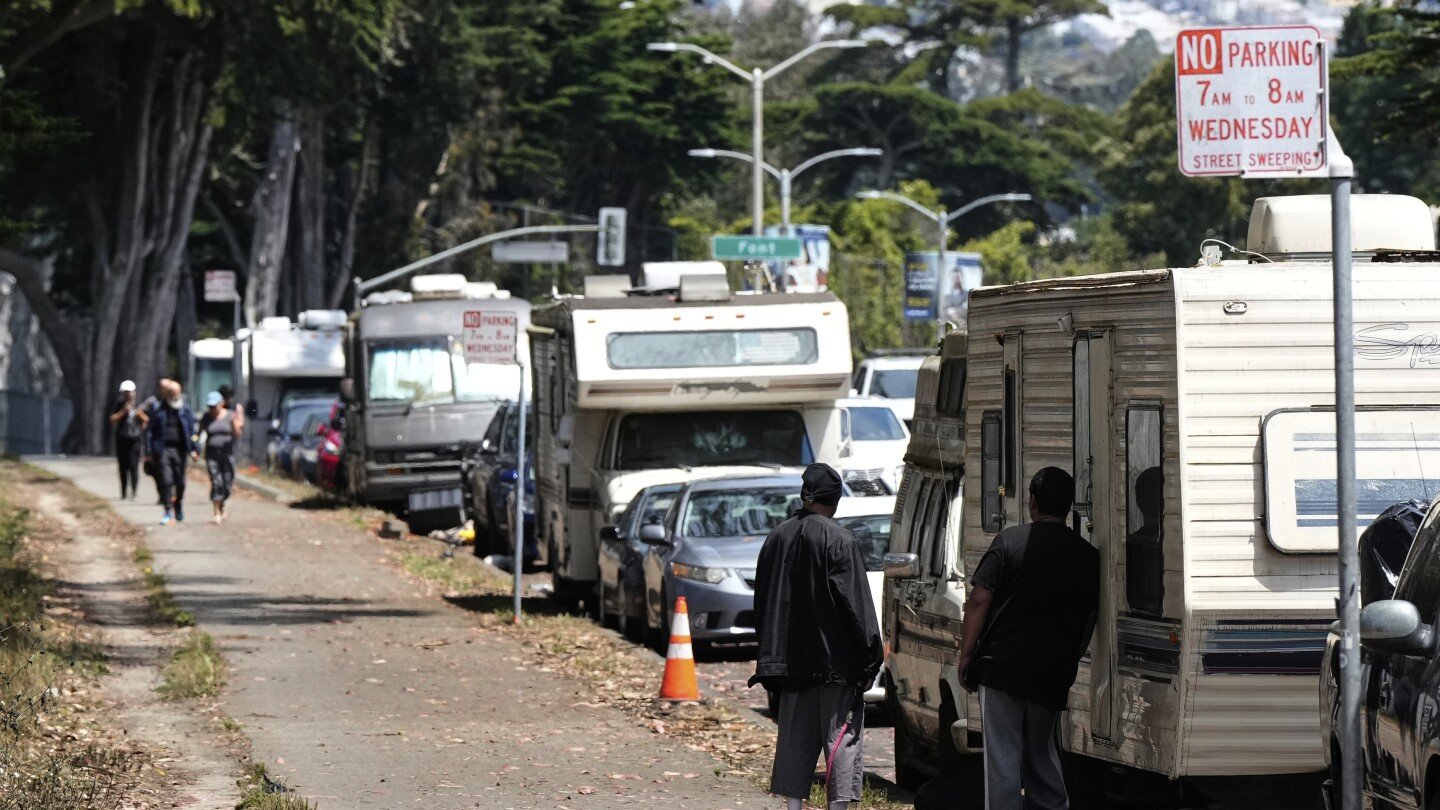Lifestyle
San Francisco to ban homeless people from living in RVs

SAN FRANCISCO (AP) — San Francisco banned homeless people from living in RVs by adopting strict new parking limits the mayor says are necessary to keep sidewalks clear and prevent trash buildup.
The policy, which received final approval by San Francisco supervisors Tuesday, targets at least 400 recreational vehicles in the city of 800,000 people. The RVs serve as shelter for people who can’t afford housing, including immigrant families with kids.
Motorists travel past RVs parked on Lake Merced Boulevard in San Francisco, Tuesday, July 15, 2025. (AP Photo/Godofredo A. Vásquez)
Those who live in them say they’re a necessary option in an expensive city where affordable apartments are impossible to find. But Mayor Daniel Lurie and other supporters of the policy say motor homes are not suitable for long-term living and the city has a duty to both provide shelter to those in need and clean up the streets.
“We absolutely want to serve those families, those who are in crisis across San Francisco,” said Kunal Modi, who advises the mayor on health, homelessness and family services. “We feel the responsibility to help them get to a stable solution. And at the same time, we want to make sure that that stability is somewhere indoors and not exposed in the public roadway.”
Critics of the plan, however, say that it’s cruel to force people to give up their only home in exchange for a shot at traditional housing when there is not nearly enough units for all the people who need help; the mayor is only offering additional money to help 65 households.
Jennifer Friedenbach, executive director of the Coalition on Homelessness, says city officials are woefully behind on establishing details of an accompanying permit program, which will exempt RV residents from parking limits so long as they are working with homeless outreach staff to find housing.
“I think that there’s going to be people who lose their RVs. I think there’s going to be people who are able to get into shelter, but at the expense” of people with higher needs, like those sleeping on a sidewalk, she said.
San Francisco, like other U.S. cities, has seen an explosion in recent years of people living out of vehicles and RVs as the cost of living has risen. Banning oversized vehicles is part of Lurie’s pledge to clean up San Francisco streets, and part of a growing trend to require homeless people to accept offers of shelter or risk arrest or tows.
Strict new rules
On Tuesday, about three dozen people gathered outside City Hall and marched somberly through the building, hoping to influence supervisors to vote against the measure. But it cleared the Board of Supervisors with two of 11 supervisors voting “no.” Supervisors made no remarks.
The proposal sets a two-hour parking limit citywide for all RVs and oversized vehicles longer than 22 feet (7 meters) or higher than 7 feet (2 meters), regardless of whether they are being used as housing.
Under the accompanying permit program, RV residents registered with the city as of May are exempt from the parking limits. In exchange, they must accept the city’s offer of temporary or longer-term housing, and get rid of their RV when it’s time to move. The city has budgeted more than half a million dollars to buy RVs from residents at $175 per foot.
Parked RVs are seen on Lake Merced Boulevard in San Francisco, Tuesday, July 15, 2025. (AP Photo/Godofredo A. Vásquez)
The permits will last for six months. People in RVs who arrive after May will not be eligible for the permit program and must abide by the two-hour rule, which makes it impossible for a family in an RV to live within city limits.
RV dwellers can’t afford rent
Carlos Perez, 55, was among RV residents who told supervisors at a hearing this month that they could not afford the city’s high rents. Perez works full-time as a produce deliveryman and supports his brother, who lives with him and is unable to work due to a disability.
“We don’t do nothing wrong. We try to keep this street clean,” he said, as he showed his RV recently to an Associated Press journalist. “It’s not easy to be in a place like this.”
Yet, Perez also loves where he lives. The green-colored RV is decorated with a homey houseplant and has a sink and a tiny stove on which Carlos simmered a bean soup on a recent afternoon.
He’s lived in San Francisco for more than 30 years, roughly a decade of which has been in the RV in the working-class Bayview neighborhood. He can walk to work and it is close to the hospital where his brother receives dialysis multiple times a week.
Zach Bollinger started living in the vehicle a dozen years ago after realizing that no matter how hard he worked, he still struggled to pay rent.
Now he works as a ride-hail driver and pursues his love of photography. He parks near Lake Merced in the city near the Pacific Ocean and pays $35 every two to four weeks to properly dispose of waste and fill the vehicle with fresh water.
He says Lurie’s plan is shortsighted. There is not enough housing available and many prefer to live in an RV over staying at a shelter, which may have restrictive rules.
For Bollinger, who is able-bodied, maintains a clean space and has no dependents, moving to a shelter would be a step down, he says. Still, he expects to receive a permit.
“If housing were affordable, there is a very good chance I wouldn’t be out here,” he said.
City recently closed its only RV lot
RV dwellers say San Francisco should open a safe parking lot where residents could empty trash and access electricity. But city officials shuttered an RV lot in April, saying it cost about $4 million a year to service three dozen large vehicles and it failed to transition people to more stable housing.
The mayor’s new proposal comes with more money for beefed-up RV parking enforcement — but also an additional $11 million, largely for a small number of households to move to subsidized housing for a few years.
Parked RVs are seen on Lake Merced Boulevard in San Francisco, Tuesday, July 15, 2025. (AP Photo/Godofredo A. Vásquez)
Officials acknowledge that may not be sufficient to house all RV dwellers, but notes that the city also has hotel vouchers and other housing subsidies.
Erica Kisch, CEO of nonprofit Compass Family Services, which assists homeless families, says they do not support the punitive nature of the proposal but are grateful for the extra resources.
“It’s recognition that households should not be living in vehicles, that we need to do better for families, and for seniors and for anyone else who’s living in a vehicle,” she said. “San Francisco can do better, certainly.”
Lifestyle
These tips from experts can help your teenager navigate AI companions

As artificial intelligence technology becomes part of daily life, adolescents are turning to chatbots for advice, guidance and conversation. The appeal is clear: Chatbots are patient, never judgmental, supportive and always available.
That worries experts who say the booming AI industry is largely unregulated and that many parents have no idea about how their kids are using AI tools or the extent of personal information they are sharing with chatbots.
New research shows more than 70% of American teenagers have used AI companions and more than half converse with them regularly. The study by Common Sense Media focused on “AI companions,” like Character. AI, Nomi and Replika, which it defines as “digital friends or characters you can text or talk with whenever you want,” versus AI assistants or tools like ChatGPT, though it notes they can be used the same way.
It’s important that parents understand the technology. Experts suggest some things parents can do to help protect their kids:
— Start a conversation, without judgment, says Michael Robb, head researcher at Common Sense Media. Approach your teen with curiosity and basic questions: “Have you heard of AI companions?” “Do you use apps that talk to you like a friend?” Listen and understand what appeals to your teen before being dismissive or saying you’re worried about it.
— Help teens recognize that AI companions are programmed to be agreeable and validating. Explain that’s not how real relationships work and that real friends with their own points of view can help navigate difficult situations in ways that AI companions cannot.
This article is part of AP’s Be Well coverage, focusing on wellness, fitness, diet and mental health. Read more Be Well.
“One of the things that’s really concerning is not only what’s happening on screen but how much time it’s taking kids away from relationships in real life,” says Mitch Prinstein, chief of psychology at the American Psychological Association. “We need to teach kids that this is a form of entertainment. It’s not real, and it’s really important they distinguish it from reality and should not have it replace relationships in your actual life.”
The APA recently put out a health advisory on AI and adolescent well-being, and tips for parents.
— Parents should watch for signs of unhealthy attachments.
“If your teen is preferring AI interactions over real relationships or spending hours talking to AI companions, or showing that they are becoming emotionally distressed when separated from them — those are patterns that suggest AI companions might be replacing rather than complementing human connection,” Robb says.
— Parents can set rules about AI use, just like they do for screen time and social media. Have discussions about when and how AI tools can and cannot be used. Many AI companions are designed for adult use and can mimic romantic, intimate and role-playing scenarios.
While AI companions may feel supportive, children should understand the tools are not equipped to handle a real crisis or provide genuine mental health support. If kids are struggling with depression, anxiety, loneliness, an eating disorder or other mental health challenges, they need human support — whether it is family, friends or a mental health professional.
— Get informed. The more parents know about AI, the better. “I don’t think people quite get what AI can do, how many teens are using it and why it’s starting to get a little scary,” says Prinstein, one of many experts calling for regulations to ensure safety guardrails for children. “A lot of us throw our hands up and say, ‘I don’t know what this is!’ This sounds crazy!’ Unfortunately, that tells kids if you have a problem with this, don’t come to me because I am going to diminish it and belittle it.”
Older teenagers have advice, too, for parents and kids. Banning AI tools is not a solution because the technology is becoming ubiquitous, says Ganesh Nair, 18.
“Trying not to use AI is like trying to not use social media today. It is too ingrained in everything we do,” says Nair, who is trying to step back from using AI companions after seeing them affect real-life friendships in his high school. “The best way you can try to regulate it is to embrace being challenged.”
“Anything that is difficult, AI can make easy. But that is a problem,” says Nair. “Actively seek out challenges, whether academic or personal. If you fall for the idea that easier is better, then you are the most vulnerable to being absorbed into this newly artificial world.”
___
The Associated Press’ education coverage receives financial support from multiple private foundations. AP is solely responsible for all content. Find AP’s standards for working with philanthropies, a list of supporters and funded coverage areas at AP.org.
Lifestyle
How to cook delicious meals in a vacation rental house

We are officially in the thick of summer. If we’re lucky, we might get a break from the routine and head for the beach, the mountains or maybe discover a new city.
For many, that means renting a vacation home — with an unfamiliar kitchen.
At home, you probably have a variety of cooking utensils, a meaningful collection of herbs and spices, and the ability to select just the right pan for your dish. But as you step into your Airbnb or Vrbo, you’re suddenly left wondering where to even put your groceries.
There’s a weird pleasure (at least for nerds like me) in pulling together a meal in a sparse, funky rental-house kitchen. It’s like a reality cooking show challenge. Can you make an omelet in a saucepan? Perhaps you don’t have fresh oregano … maybe those parsley stems will work? Can you stretch that small bottle of olive oil through the last two days of your trip? I’ll call that conundrum, and I’ll raise you a half a jar of gherkins.
During rental home vacations, it’s kind of fun to be untethered from the normal cooking routine. Believe you me, I’m racing out for fried clams at the local seafood joint as many nights as my budget and waistband allow. But for the meals I’m cooking, I’m relinquishing notions of perfection in favor of scrappiness.
Picked up a whole lot of cherry tomatoes at a farmstand? You’re making cherry tomato antipasti salad with some canned artichoke hearts, olives, onions and a quick vinaigrette. Maybe throw in some cubed provolone or diced salami. Peaches getting a bit too soft? Time for a smoothie.
There’s something liberating — and a little bit ridiculous — about cooking in a vacation rental kitchen.
Bring some essentials of your own
Before you go, consider packing a minimalist “kitchen survival kit.” It doesn’t have to be much: A sharp knife, a cutting board, salt and pepper, and whatever pantry staples you know you’ll need to get started.
For me, I might pack olive oil, vinegar, lemons, Dijon mustard and a couple of my favorite herbs and spices. I also always bring zipper-top bags and some small containers for leftovers or taking food on the go.
Use the rental’s features (and lack thereof) to your advantage
Think about dishes that can stretch ingredients, and about welcome substitutions. A big grain salad — made with rice, quinoa or couscous — is endlessly customizable and can be served cold or at room temperature (think lakeside lunch or a backyard meal).
I would also start with things that don’t require an oven — you never know if it heats unevenly, or at all (it might be a glorified bread box). A stovetop pasta tossed with sauteed garlic and olive oil is always a win. Add red pepper flakes and grated Parmesan if you have it.
Grills are often available and can be a vacation cook’s best friend — as long as you’ve got an ample supply of the right fuel for it. Grill up simply seasoned chicken breasts or New York Strip steaks for dinner and very intentionally make extra — those leftovers will be perfect sliced and used for sandwiches, quesadillas, salads or wraps. Extra grilled corn might become a corn soup or chowder, a corn salad or something to add to a stir-fry.
Think about brushing some slices of country bread with olive oil, sprinkling with flaky salt and toasting them lightly on the grill. Top with fresh sliced or chopped tomatoes with some basil, or turn them into whatever type of bruschetta you can whip up from your farmstand haul. Think caponata, sauteed chard or maybe a heap of sliced grilled peppers with some fresh goat cheese.
Salads are always on the docket. Again, easy to improvise with farmers market ingredients. But this is your vacation, and you should feel free to play. Try a melon and cucumber salad with a bit of feta and a squeeze of lime juice, or a chopped vegetable salad bolstered with protein-packed chickpeas.
Think creatively and accept imperfection
As you come to the end of your trip and you need to use things up, get creative. That half jar of pickles will add a briny punch to a potato salad. That nub of leftover cheese and that last bunch of spinach will be great chopped up and added to scrambled eggs or a frittata.
Cook what feels manageable, what makes use of local ingredients and what gives you more time outside with your people. Yes, you might be chopping vegetables with a serrated steak knife. Yes, there might be a little sand in the pasta salad as you serve it up on the beach. That’s OK.
Some of the best vacation meals come from embracing the fact that you’re cooking without your usual tools and supplies. That’s half the fun. I once made a great dinner from fresh scallops, a box of pasta, olive oil and a jug of margarita mix. That was 20 years ago, and we all still remember it.
Peach and plum yogurt smoothie
For their versatility and simplicity, smoothies can make for a vacation staple.
This is your smoothie template. Swap around fruits, yogurt flavors, sweeteners and see if you can find a NutriBullet in the back of the cabinet. Also, if you plan ahead, you might freeze your fruit for a thicker smoothie, or just add some ice. If you’ve got some fresh mint, toss that in, too.
Ingredients:
1 cup (8 ounces) vanilla Greek yogurt
1 cup (8 ounces) peach yogurt
1 tablespoon honey or agave, or to taste
2 cups cubed peeled peaches
2 cups cubed peeled plums
Instructions:
1. Place the vanilla yogurt, peach yogurt, honey, peaches and plums in a blender. Blend well.
2. Pour into glasses and serve.
Lifestyle
Ozzy Osbourne: How he became a cuddly family figure on ‘The Osbournes’

LOS ANGELES (AP) — There was Ozzy before “The Osbournes” and Ozzy after “The Osbournes.”
For much of his life, the Black Sabbath founder and legendary heavy metal frontman who died at 76 on Tuesday was known to much of the public as a dark purveyor of deeds ranging from decadent to downright Satanic.
Wild stories followed him. Clergy condemned him. Parents sued him.
But with the debut of his family reality show on MTV, the world learned what those who’d been paying closer attention already knew: Ozzy Osbourne was soft and fuzzy under the darkness.
During its relatively short run from 2002 to 2005, “The Osbournes” became a runaway hit and made stars of his wife Sharon and kids Jack and Kelly. But more than that, it made a star of the domesticated version of Ozzy Osbourne, and in the process changed reality TV.
In 2025, when virtually every variety of celebrity has had a reality show, it’s hard to see what a novelty the series was. MTV sold it as television’s first “reality sitcom.”
“Just the idea of the Black Sabbath founder, who will forever be known for biting the head off a bat during a 1982 concert, as a family man seems strange,” Associated Press Media Writer David Bauder wrote on the eve of “The Osbournes” premiere. But on the show, Osbourne was “sweetly funny — and under everything a lot like the put-upon dads you’ve been seeing in television sitcoms for generations.”
Danny Deraney, a publicist who worked with Osbourne and was a lifelong fan, said of the show, “You saw some guy who was curious. You saw some guy who was being funny. You just saw pretty much the real thing.”
“He’s not the guy that everyone associates with the ‘Prince of Darkness’ and all this craziness,” Deraney said. “And people loved him. He became so affable to so many people because of that show. As metal fans, we knew it. We knew that’s who he was. But now everyone knew.”
Reality shows at the time, especially the popular competition shows like “Survivor,” thrived on heightened circumstances. For “The Osbournes,” no stakes were too low.
They sat on the couch. They ate dinner. The now-sober Ozzy sipped Diet Cokes, and urged his kids not to indulge in alcohol or drugs when they went out. He struggled to find the History Channel on his satellite TV. They feuded with the neighbors because, of all things, their loud music was driving the Osbournes crazy.
“You were seeing this really fascinating, appealing, bizarre tension between the public persona of a celebrity and their mundane experiences at home,” said Kathryn VanArendonk, a critic for Vulture and New York Magazine.
The sitcom tone was apparent from its first moments.
“You turn on this show and you get this like little jazzy cover theme song of the song ‘Crazy Train,’ and there’s all these bright colors and fancy editing, and we just got to see this like totally 180-degree different side of Ozzy which was just surprising and incredible to watch,” said Nick Caruso, staff editor at TVLine.
Like family sitcoms, the affection its leads clearly had for each other was essential to its appeal.
“For some reason, we kind of just fell in love with them the same way that we grew to love Ozzy and Sharon as like a marital unit,” Caruso said.
What was maybe strangest about the show was how not-strange it felt. The two Ozzies seemed seamless rather than contradictory.
“You’re realizing that these things are personas and that all personas are these like elaborate complex mosaics of like who a person is,” VanArendonk said.
“The Osbournes” had both an immediate and a long-term affect on the genre.
Both Caruso and VanArendonk said shows like “Newlyweds: Nick and Jessica,” which followed then-pop stars Jessica Simpson and Nick Lachey after they married, was clearly a descendant.
And countless other shows felt its influence, from “The Kardashians” to “The Baldwins” — the recently debuted reality series on Alec Baldwin, his wife Hilaria and their seven kids.
“‘The Baldwins’ as a reality show is explicitly modeled on ‘The Osbournes,’ VanArendonk said. ”It’s like you have these famous people and now you get to see what their home lives are like, what they are like as parents, what they’re eating, what they are taking on with them on vacation, who their pets are, and they are these sort of cuddly, warm, eccentric figures.”
-

 Lifestyle5 days ago
Lifestyle5 days agoSouth African cooks aim to stir up 67,000 liters of soup to fight hunger on Mandela Day
-

 Asia5 days ago
Asia5 days agoForced from Bhutan, deported by the US: these stateless Himalayan people are in a unique limbo
-

 Africa4 days ago
Africa4 days agoAtlas Lionesses roar into Afcon semi-finals, sparking celebrations in Rabat
-

 Europe4 days ago
Europe4 days agoL’Etape du Tour: How amateurs measure themselves up to pros on one of the world’s toughest stages
-

 Sports3 days ago
Sports3 days agoUnrelenting Scottie Scheffler leaves Open field in his wake. Can anyone catch him?
-

 Africa4 days ago
Africa4 days agoCooks spice things up for soup challenge as South Africa marks Mandela Day
-

 Africa4 days ago
Africa4 days agoRwandan opposition leader Victoire Ingabire denied bail
-

 Asia2 days ago
Asia2 days agoA couple were accused of having an ‘illicit’ relationship. Their community allegedly shot them dead




